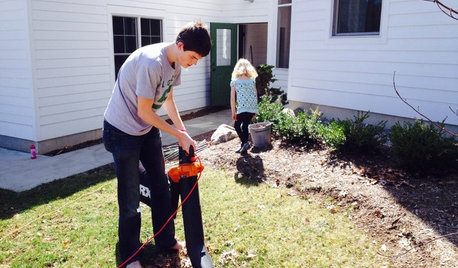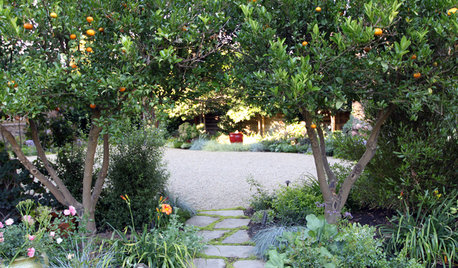Are dead leaves better than woodchips for compost?
ahappy camper zone10
5 years ago
last modified: 5 years ago
Featured Answer
Sort by:Oldest
Comments (62)
armoured
5 years agodaninthedirt (USDA 9a, HZ9, CentTX, Sunset z30, Cfa)
5 years agolast modified: 5 years agoRelated Discussions
Using dead vegetable plants in compost
Comments (7)I will discard my infested dead cabbage family plants because they have the harlequin beetle eggs in them. Not sure if the composting heat will kill them and I sure don't want them back. I also discard grassy weeds that have gone to seed (I am going for a non grass garden). There is one seed in particular that we avoid since its prickly and gets into our skins and hurt the dogs too. Not too worried about the other more benign seeds and the heat will hopefully kill them anyway. I compost everything else. I have a mulcher, so branches, dead leaves, cuttings from rose prunings, decaying fruit from the trees, all goes into the compost....See MoreYet another woodchip/compost/soil question!
Comments (48)I am not positive about peat being renewable or not. I do know that it is dug up and processed and wrapped in plastic and shipped hundreds if not thousands of miles to garden centers around the planet. I see no reason for buying such a product when I can make compost and use leaves and horse manure and all sorts of other items to hold water and provide a good environment for my plants. The only having to water every other day with peat line was funny to me, I don't even water my container plants every other day. I put compost, leaves, and/or old horse manure in with the soil in my outdoor containers. Holds water really well, helps that I have a clay soil to start with. When there is an option, I go for locally available and free garden ingredients instead of buying stuff at the store. Not everyone has the time or inclination for that, but it is undeniably 1) cheaper, and 2) better for the planet to use the local organic material instead of the processed, transported, plastic wrapped stuff. Marcia, who rarely hugs trees, but did dance around one with a lot of friends and ribbons on Saturday (Maypole)...See MoreBetter late than never?
Comments (15)Dear Estreya, Check with your local waste-management firm or city/county government. MANY companies and local governments across the US (and Canada) provide subsidized--low-price--compost bins as part of the almost universal effort to reduce waste going to landfills. Your local government/waste-management firm may also offer classes in composting. Sometimes attendance at a class is required to qualify for a subsidized bin; it's all up to the local authorities. There are TONS of Internet sites on how to make compost. Many of them have lists of "green" and "brown" ingredients (hint: do NOT go by color of the ingredient) suitable for compost. Also: most of those same Internet sites will give conservative lists of ingredients. Many who post on these forums are more radical/free-wheeling with their compost ingredients. As a beginner, it might be good to start off conservatively and then, as you gain experience, make more radical choices. I'm somewhere in between after 20+ years of making compost. It becomes a lot of FUN once you get used to throwing stuff into the "pile" rather than the "garbage." Welcome to the world of compost. in el cerrito...See MoreIt just doesn't get any better than this!
Comments (1)Wow, You are super productive! I see warm weather agrees with you. An aunt passed away 5 weeks ago, and her husband, by 2nd marriage, is pushing the family to get things out of the house. My time is being used helping my cousin. I wish I could be home babying my yard as much as you! 6 more days of school, and I will have more time to do the yard well! Dee...See MoreJohn D Zn6a PIT Pa
5 years agoJohn D Zn6a PIT Pa
5 years agoRichard Brennan
5 years agolast modified: 5 years agoarmoured
5 years agodaninthedirt (USDA 9a, HZ9, CentTX, Sunset z30, Cfa)
5 years agolast modified: 5 years agotoxcrusadr
5 years agolast modified: 5 years agoharold100
5 years agodaninthedirt (USDA 9a, HZ9, CentTX, Sunset z30, Cfa)
5 years agolast modified: 5 years agotoxcrusadr
5 years agodaninthedirt (USDA 9a, HZ9, CentTX, Sunset z30, Cfa)
5 years agolast modified: 5 years agoRichard Brennan
5 years agodaninthedirt (USDA 9a, HZ9, CentTX, Sunset z30, Cfa)
5 years agolast modified: 5 years agovgkg Z-7 Va
5 years agoharold100
5 years agotoxcrusadr
5 years agodaninthedirt (USDA 9a, HZ9, CentTX, Sunset z30, Cfa)
5 years agolast modified: 5 years agodaninthedirt (USDA 9a, HZ9, CentTX, Sunset z30, Cfa)
5 years agolast modified: 5 years agogardengal48 (PNW Z8/9)
5 years agoRichard Brennan
5 years agolast modified: 5 years agodaninthedirt (USDA 9a, HZ9, CentTX, Sunset z30, Cfa)
5 years agolast modified: 5 years agowayne_5 zone 6a Central Indiana
5 years agodaninthedirt (USDA 9a, HZ9, CentTX, Sunset z30, Cfa)
5 years agolast modified: 5 years agoJohn D Zn6a PIT Pa
5 years agotoxcrusadr
5 years agosteve2416
5 years agosteve2416
5 years agoavgusta_gw
5 years agolast modified: 5 years agoavgusta_gw
5 years agodaninthedirt (USDA 9a, HZ9, CentTX, Sunset z30, Cfa)
5 years agolast modified: 5 years agogardengal48 (PNW Z8/9)
5 years agogardengal48 (PNW Z8/9)
5 years agodaninthedirt (USDA 9a, HZ9, CentTX, Sunset z30, Cfa)
5 years agolast modified: 5 years agoavgusta_gw
5 years agolast modified: 5 years agodaninthedirt (USDA 9a, HZ9, CentTX, Sunset z30, Cfa)
5 years agolast modified: 5 years agoavgusta_gw
5 years agodaninthedirt (USDA 9a, HZ9, CentTX, Sunset z30, Cfa)
5 years agolast modified: 5 years agoavgusta_gw
5 years agolast modified: 5 years agoarmoured
5 years agotoxcrusadr
5 years agowayne_5 zone 6a Central Indiana
5 years agolast modified: 5 years agopurslanegarden
5 years ago
Related Stories

LIGHTING3 Ways LED Lights Are Better Than Ever
See how improved technology has made LED lightbulbs smaller, brighter and more colorful
Full Story
LIFEChore Time: How to Work Better as a Family
That’s not just a crumb-strewn counter or a yard scattered with leaves. It’s a valuable opportunity
Full Story
SMALL KITCHENSThe 100-Square-Foot Kitchen: No More Dead Ends
Removing an angled peninsula and creating a slim island provide better traffic flow and a more airy layout
Full Story
DECORATING GUIDES12 Deadly Decorating Sins
Are your room designs suffering from a few old habits? It may be time to change your ways
Full Story
BATHROOM DESIGNHow to Build a Better Shower Curb
Work with your contractors and installers to ensure a safe, stylish curb that keeps the water where it belongs
Full Story
GARDENING GUIDESGet on a Composting Kick (Hello, Free Fertilizer!)
Quit shelling out for pricey substitutes that aren’t even as good. Here’s how to give your soil the best while lightening your trash load
Full Story
FALL GARDENING5 Ways to Put Fall Leaves to Work in Your Garden
Improve your soil and yard the organic way with a valuable garden booster that grows on trees
Full Story
GARDENING GUIDESLearn the Secret to Bigger and Better Roses
Grow beautiful roses using both ordinary and unusual soil amendments
Full Story
GARDENING GUIDESHow to Become a Better Gardener
Expand the beauty and comfort of home by cultivating your yard for food, beauty and supporting nature. Here's your guide
Full Story
DECLUTTERINGDownsizing Help: Choosing What Furniture to Leave Behind
What to take, what to buy, how to make your favorite furniture fit ... get some answers from a homeowner who scaled way down
Full Story


daninthedirt (USDA 9a, HZ9, CentTX, Sunset z30, Cfa)